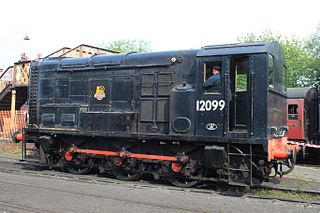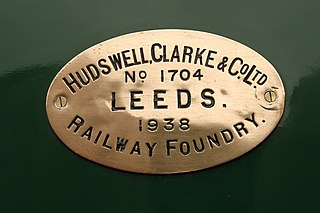This page is based on this
Wikipedia article Text is available under the
CC BY-SA 4.0 license; additional terms may apply.
Images, videos and audio are available under their respective licenses.

The British Rail Class 11 was applied to a batch of diesel shunting locomotives built from April 1945 to December 1952, based on a similar earlier batch built by the London, Midland and Scottish Railway (LMS) between 1934 and 1936.

The steam locomotives of British Railways were used by British Railways over the period 1948–1968. The vast majority of these were inherited from its four constituent companies, the "Big Four".
A number of different numbering and classification schemes were used for locomotives and multiple units operated by British Railways (BR), and this page explains the principal systems. This section also covers the post-privatisation period, as the broad numbering and classification arrangements have not altered since the break-up of BR.
Before the TOPS Class 97 was issued to self-propelled locomotives in departmental use, British Rail had such locomotives numbered in a variety of series, together with locomotives that were no longer self-propelled. See Also:

The British Railways Class D3/7 were a class of 0-6-0 diesel electric shunting locomotives built as LMS Nos. 7080–7119. The class were built from May 1939 through to July 1942 by the London, Midland and Scottish Railway at their Derby Works using a diesel electric transmission supplied by English Electric.
The London, Midland and Scottish Railway (LMS) pioneered the use of diesel shunting locomotives in Great Britain. The variety of experimental and production diesel shunters produced by the LMS is summarised below. In each heading, the first number(s) carried are shown first, with subsequent renumbering(s) following the "/".
The Great Western Railway purchased two diesel shunters, and ordered a further seven immediately prior to Nationalisation, which were delivered to British Rail in 1948-49. The two shunters used by the GWR were numbered 1 and 2, while a series commencing at 501 was planned for the new locomotives ordered in the 1940s. British Rail numbered 2 and the new locomotives in a series commencing at 15100.
A number of different numbering and classification schemes were used for the locomotives owned by the London, Midland and Scottish Railway (LMS) and its constituent companies; this page explains the principal systems that were used.
No. 1831 was the first experimental diesel hydraulic shunter of the London, Midland and Scottish Railway (LMS) which pioneered diesel shunting in the UK. It was introduced in 1932, built at Midland Railway's Derby Works. It was nominally a rebuild of a Midland Railway 1377 Class 0-6-0T steam locomotive of the same number, built in September 1892 by the Vulcan Foundry. The frames and running gear of the original locomotive were retained.

LMS diesel shunter 7050 is an experimental 0-4-0 diesel-mechanical shunting locomotive, introduced by the London Midland and Scottish Railway (LMSR) in 1934 and which remained in service with that railway for six years. It was later acquired for military use and is now preserved at the National Railway Museum.

Class D3/6 were diesel shunters built in 1935 by English Electric for the London, Midland and Scottish Railway. They were the first of a new design of diesel shunters based on the English Electric 6K of 350 horsepower (260 kW) diesel engine. Similar prototypes were built for the Southern Railway (SR1-3), Great Western Railway (GWR2), and London and North Eastern Railway (8000-8004). They were all substantially similar, with the long bonnet ("nose"), 0-6-0 wheel arrangement, EE 6K prime mover and 2 axle-hung traction motors. This configuration was repeated in most subsequent large diesel shunters built in Britain, such as the British Rail Class 11 and even more numerous British Rail Class 08 that entered service after World War II.
A number of different numbering and classification schemes were used for the locomotives owned by the London and North Eastern Railway (LNER) and its constituent companies. This page explains the principal systems that were used. The following abbreviations for the constituent companies are used on this page:
LMS diesel shunter 7052 was an experimental 0-6-0 diesel-mechanical shunting locomotive, introduced by the London Midland and Scottish Railway (LMSR) in 1934 and which remained in service with that railway for six years. It was later acquired for military use until 1966.
LMS diesel shunter 7054 was initially allocated the number 7404 but this number was never carried. It was supplied by the Hunslet Engine Company in 1934. Testing started in October 1934 and it was taken into LMS stock in November 1934.
LMS diesel shunter 7057, later to become NCC Class 22, was built by Harland & Wolff. Testing started in July 1934 and the locomotive was taken into LMS stock in February 1935. It was loaned to the War Department between 1941-1943, which numbered it 233. It was withdrawn from LMS stock in January 1944 and sold back to Harland & Wolff, which rebuilt it with a new 225 hp (168 kW) engine and converted it to the 5 ft 3 in gauge. It was then sold to the Northern Counties Committee, which numbered it 22. It was finally withdrawn in April 1965 and scrapped at the close of that year.
LMS diesel shunter 7058 was based on an earlier Armstrong Whitworth prototype of 1932, which had been tested by the London, Midland and Scottish Railway. It was initially numbered 7408 and then re-numbered 7058.
The War Department ex-LMS Fowler Class 3F consisted of 8 LMS Fowler Class 3F 0-6-0T steam locomotives requisitioned in 1940 from the London Midland and Scottish Railway (LMS).
LMS diesel shunters 7059–7068 were 0-6-0 diesel-electric shunters built by Armstrong Whitworth in 1936. Maker's numbers D54-D63. The diesel engine was an Armstrong-Sulzer 6LTD22 of 350 bhp at 875 rpm. There was a single Crompton Parkinson traction motor with a rating of 231 hp (continuous) or 358 hp. Final drive was by double reduction gears of 11.1:1 ratio and jackshafts. These locomotives were similar in appearance to LMS 7080–7119 although the internal equipment was different. They started work in 1936 and were allocated to Crewe South (7059–7063) and Kingmoor (7064–7068).






